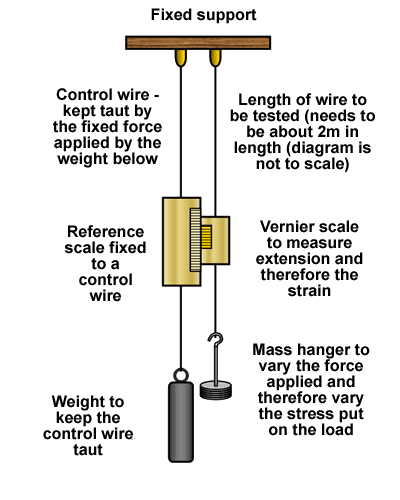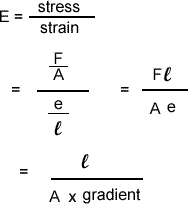An experiment to measure the Young's Modulus

 To minimise errors the control wire is the same length, diameter and material as the test wire. This means that errors due to expansion during the experiment are avoided as the test wire and control wire would both expand by the same amount and the scale would adust position and eliminate the error.
To minimise errors the control wire is the same length, diameter and material as the test wire. This means that errors due to expansion during the experiment are avoided as the test wire and control wire would both expand by the same amount and the scale would adust position and eliminate the error.
 The wire must have no kinks in it otherwise there will be big extensions due to the wire straightening out rather than just stretching.
The wire must have no kinks in it otherwise there will be big extensions due to the wire straightening out rather than just stretching.
 Care must be taken that the limit of proportionality is not exceeded. This can be checked by removing the load after each addition of the weight. If the limit has not been exceeded the wire should return to the length it was before the weight was added.
Care must be taken that the limit of proportionality is not exceeded. This can be checked by removing the load after each addition of the weight. If the limit has not been exceeded the wire should return to the length it was before the weight was added.
 The wire must be as long as possible (usually about 2m long) and as thin as possible so that as big an extension as possible can be recorded. (A typical extension for a 5N loading will be 1mm).
The wire must be as long as possible (usually about 2m long) and as thin as possible so that as big an extension as possible can be recorded. (A typical extension for a 5N loading will be 1mm).
Possible Risks
 Heavy weights can cause problems if dropped on someone's toe. Care must be taken not to stand so that the masses are over your foot!
Heavy weights can cause problems if dropped on someone's toe. Care must be taken not to stand so that the masses are over your foot!
 The wire is very thin and taut. It is possible to cut yourself on it if you walk into it. The area you are working in should be 'fenced off' so that someone doesn't husrt themsleves.
The wire is very thin and taut. It is possible to cut yourself on it if you walk into it. The area you are working in should be 'fenced off' so that someone doesn't husrt themsleves.
 The wire might snap. If it does it might whip into your face and eyes. Goggles should be worn and the area around the wire should be clear so that if you have to move out of the way you can do so quickly.
The wire might snap. If it does it might whip into your face and eyes. Goggles should be worn and the area around the wire should be clear so that if you have to move out of the way you can do so quickly.
Procedure
 The test wire is loaded with the weight hanger so that it is taut before readings are taken.
The test wire is loaded with the weight hanger so that it is taut before readings are taken.
 The vernier scale is read and the result recorded as addition of 0N.
The vernier scale is read and the result recorded as addition of 0N.
 Weights - usually starting at 0N and increasing in 5N increments to 100N - are then added and a reading of the vernier scale is taken at each addition.
Weights - usually starting at 0N and increasing in 5N increments to 100N - are then added and a reading of the vernier scale is taken at each addition.
 The experiment should be repeated twice and any anomalous results repeated and checked.
The experiment should be repeated twice and any anomalous results repeated and checked.
 A graph of extension (Y-axis) against load (X-axis) is plotted. It should be a straight line through the origin.
A graph of extension (Y-axis) against load (X-axis) is plotted. It should be a straight line through the origin.

 The gradient of that graph will be e/F.
The gradient of that graph will be e/F.
 Using that value we can find the value of Young's Modulus for the wire.
Using that value we can find the value of Young's Modulus for the wire.

 Click here to find out about the Young Modulus
Click here to find out about the Young Modulus
 Click here to find out about the difference between brittle, plastic and ductile behaviour.
Click here to find out about the difference between brittle, plastic and ductile behaviour.


